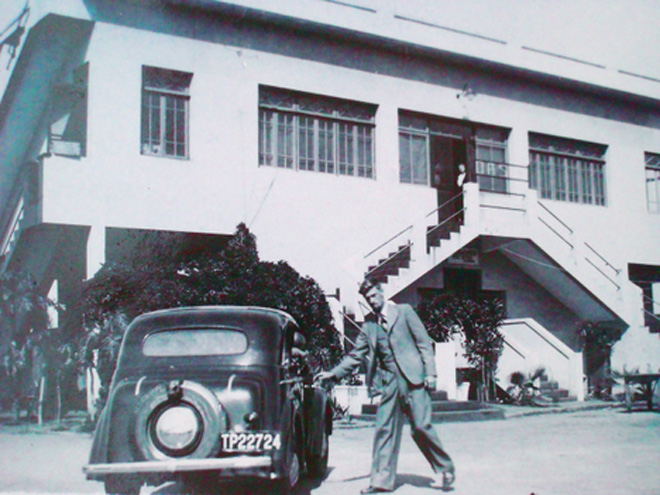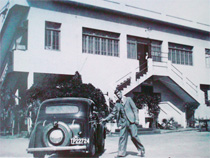In the summer of 1973 a submarine periscope surfaced beyond the Praia Sepulveda (Praia Xai-Xai) reef. The significance of this unfamiliar sight at our Mozambique holiday destination only became clear the following year when Portugal handed over its colony to a unilaterally installed Frelimo government. Borders were closed and new faces appeared from Russia, East Germany and other foreign countries.
It was 20 years later when we again took the road to Xai-Xai. Making our way through a country torn apart by a 17-year civil war, we were reminiscing about the time in 1946 when we left Lourenco Marques behind and ventured farther north to explore Praia Sepulveda in our 1938 Opel Kadett, running on World War II Harley Davidson tyres.
The most horrible strip concrete road with sharp tyre-cutting edges existed up to Vila Luisa (Marracuene). Thereafter the dirt road was in as good a state of repair as dongas created by heavy trucks and buses allowed, until the arrival of the next road-grading season. The 20km Limpopo River flood plain on the approach to Vila de Joao Belo (Xai-Xai) was notorious for its heavy black turf that mercilessly bogged down traffic in the rainy season.
Several years’ construction work later resulted in a new road raised well above the Limpopo River flood plain. The engineers unfortunately did not reckon with nature and, when the floods of 2001 came, the odd viaducts under the road could not cope with the mass of water that accumulated in a massive lake against the dam “wall”.
Xai-Xai itself was under water. Eventually the wall broke in several places. The water rushed down to the ocean with such force that the Limpopo River’s course dramatically changed at the Inhampura Mouth, where the lower Zongoene Lodge bungalows were under water up to their roofs.
Over the years the Limpopo River contributed its fair share to the shaping of Mozambican history. It was also known by many other names such as Crocodile River, Gold River, Miti River, River of Kings and Inhampura River. From the river mouth at Inhampura it was navigable by steamers up to eight feet in draught as far as Languene, a village just above Vila de Joao Belo.
It was a beautiful sight to see the coastal steamers Rio do Limpopo and Xai-Xai regularly navigating the 30km river to Xai-Xai, through rice paddies and green pastures filled with black and white Friesland cows belonging to the Manuel Mendes dairy farm. After both steamers were lost crossing the sandbar at Inhampura, this romantic picture disappeared.
For a time the ferry at Vila de Joao Belo (Xai-Xai) compensated with its own unique river crossing adventure. The ferry was pulled across the river by hand along two steel cables stretching from the one bank to the other. The rhythmic stamping of feet, singing and the sight of schools of giant silvery mullet jumping in car lights was something to behold. This faded into history when a bridge was constructed in the late Fifties and early Sixties. At that time there were still hippos and crocodiles lazing on the sand banks near the ferry.
The bridge across the Limpopo River was designed by Professor Edgar Cardoso, famous for the masterwork Salazar Bridge across the Tagus River in Lisbon, Portugal. He was also responsible for the bridge across the Zambezi at Tete, the bridge across the Save River on the Great North Road and the bridge to Mozambique Island.
Like the Limpopo River the coastline also contributed much to Mozambique’s maritime history.
Praia Sepulveda derived its name from a Portuguese nobleman, Dom Manuel de Sousa Sepulveda who, with his family and other passengers on board the Sao Joao, was shipwrecked at what later became known as Port St Johns, after Sao Joao.
The people who survived the shipwreck walked to Lourenco Marques, and when they discovered that no ship was expected for months to take them home, they decided to march a further 1000km north to Sofala.
They were warned about an unfriendly tribe near the Limpopo, but ignored the advice not to proceed. They were all murdered at Praia Sepulveda.
Just before independence, on 15 May 1972, the 12 942-ton Greek freighter Cape Nerita beached at Praia Corea, north of Praia Sepulveda. By the looks of it, a sort of tsunami must have been responsible for this strange beach sight. When we again visited the site after the war, we discovered that the ship had been cut to pieces and removed to scrap yards. Only the bottom section below the sand remains today.
World War II contributed the motor tanker Africa Shell, under command of Captain Patric G Dove, to the shipwrecks off Ponta Zavora. The ship was captured and sunk on 15 November 1939 by the famous Deutschland class cruiser, Pantzerschiff Admiral Graf Spee. The diesel-powered (quite uncommon at the time) Graf Spee then returned to the Atlantic Ocean, and its end was later dramatised in the 1956 film “The Battle of the Rio Plate”. The 1940 movie, “For Freedom” was a dramatisation of the capture of the Africa Shell.
The Praia Sepulveda Bay was well protected from sharks by a coastal reef until an overzealous fisherman blew a gateway to the sea for his fishing boat. Naturally the sharks came to explore new waters and a very good friend of ours, Ellio, lost an arm in an attack. Dr Albert Wessels and his son Bert from Toyota saved a man’s life on another occasion when he was badly mauled by a shark.
At the Old Bay, a kilometre or two from the Praia towards Inhampura, was the oldest house in the area. After the war we discovered a Russian monument containing the ashes of a Russian geologist, Igor Areshtovitch, on one of the dunes near the house. However, the 2001 floods washed the monument down to the sea and it was evident that unless salvaged, it was going to end up in the ocean. I informed the Russian High Commission in Pretoria of the circumstances, and that is the last I know of the fate of the monument.
A fate more relevant to us was that of our holiday residence in Mozambique. My father was the first South African to whom a property lease was granted at Praia Sepulveda to build a house. A week before independence he specially travelled to Xai-Xai to ensure that all rates and taxes were up to date when the new Government took over. Little did we expect that the Frelimo Government would in gratitude nationalise all properties!
Ex Afrika semper aliquid novi!









